• MODERN SCIENCE, NATURAL HISTORY, and TEK: We hope to have volunteers utilizing a spectrum of observational stances and techniques, ranging from the quantitative rigor of modern science (including citizen science), to the more qualitative emphases of the western tradition of natural history, and (if possible) Traditional Ecological Knowledge, TEK, as practiced by experienced or new learners of this Indigenous form of science and right relationship.
For those unfamiliar with the "Traditional Ecological Knowledge" (TEK), here is online access to and a lengthy excerpt from a 2002 article by ROBIN WALL KIMMERER, "Weaving Traditional Ecological Knowledge into Biological Education: A Call to Action", in BioScience:
"Traditional ecological knowledge is not unique to Native American culture but exists all over the world, independent of ethnicity. It is born of long intimacy and attentiveness to a homeland and can arise wherever people are materially and spiritually integrated with their landscape. TEK is rational and reliable knowledge that has been developed through generations of intimate contact by native peoples with their lands. TEK is being recognized as having equal status with scientific knowledge (UNEP 1998) and has been termed the 'intellectual twin to science' (DeLoria 1995). This long intellectual tradition exists in parallel to Western science, yet has been historically marginalized by the scientific community.
Traditional knowledge has much in common with scientific ecological knowledge (SEK), which is not surprising since both traditions derive from the same source: systematic observations of nature. Both knowledge systems yield detailed empirical information of natural phenomena and relationships among ecosystem components. Both SEK and TEK have predictive power, and in both intellectual traditions, observations are interpreted within a particular cultural context.
Traditional knowledge encompasses a wide range of biological information, which overlaps significantly with the content of a mainstream course in ecology or conservation biology. The scope of traditional ecological knowledge includes detailed empirical knowledge of population biology, resource assessment and monitoring, successional dynamics, patterns of fluctuation in climate and resources, species interactions, ethnotaxonomy, sustainable harvesting, and adaptive management and manipulation of disturbance regimes (Berkes 1999). Case histories of the utility of TEK in conservation biology span a range of biomes from the tundra to the tropical rainforest."
Traditional ecological knowledge differs from scientific ecological knowledge in a number of important ways. TEK observations tend to be qualitative, and they create a diachronic database, that is, a record of observations from a single locale over a long time period. The National Science Foundation, in its support of the Long-Term Ecological Research program, has validated the importance of such continuous data. In TEK, the observers tend to be the resource users themselves, for example, hunters, fishers, and gatherers whose harvesting success is inextricably linked to the quality and reliability of their ecological observations. In contrast, scientific observations made by a small group of professionals tend to be quantitative and often represent synchronic data or simultaneous observations from a wide range of sites, which frequently lack the long-term perspective of TEK. Additional differences between scientific knowledge and traditional knowledge are described in Berkes (1993).
Western science is conducted in an academic culture in which nature is viewed strictly objectively. In this aspect, TEK diverges significantly from Western science (Pierotti and Wildcat 2000). TEK is much more than the empirical information concerning ecological relationships. Unlike SEK, traditional knowledge is woven into and is inseparable from the social and spiritual context of the culture. Traditional knowledge can rival Western science as a body of empirical information, but traditional knowledge may also extend its explanatory power beyond the strictly empirical, where science cannot go. TEK is laden with associated values, while the scientific community prides itself on data that are "value free." TEK includes an ethic of reciprocal respect and obligations between humans and the nonhuman world. In indigenous science, nature is subject, not object. Such holistic ways of understanding the environment offer alternatives to the dominant consumptive values of Western societies (Berkes 1999, Hunn 1999). Embraced as an equal partner to the power of Western science, TEK offers not only important biological insights but a cultural framework for environmental problem solving that incorporates human values.
• GUIDANCE from Western Science and Natural History Perspectives
List prepared by science writer, Connie Barlow:
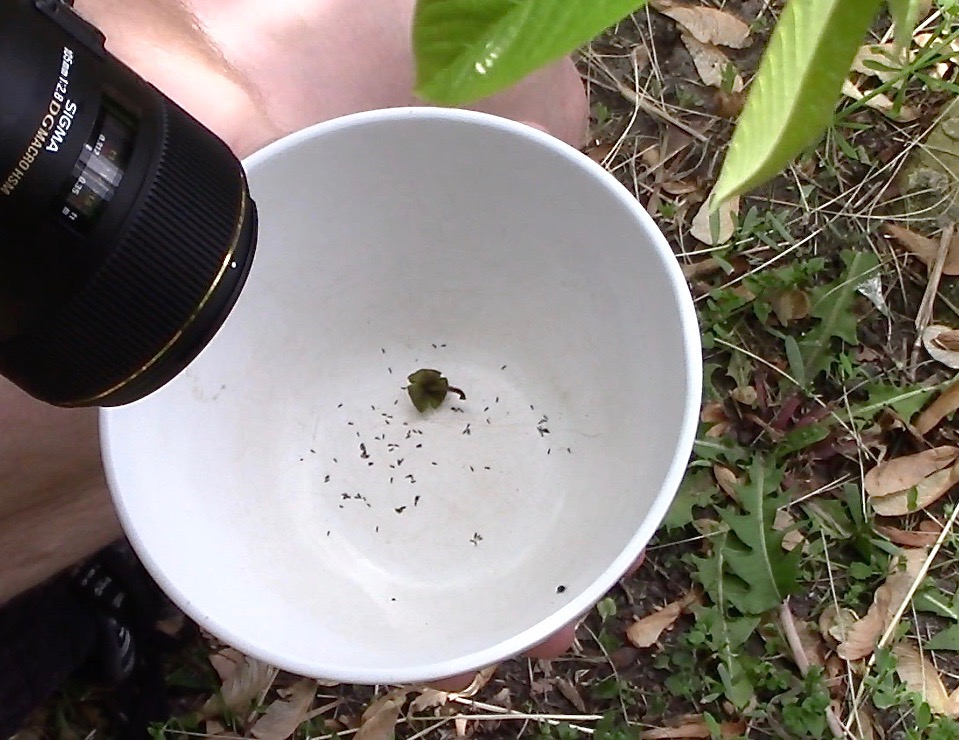 |
|
PREPARATION: TEAM AND EQUIPMENT: Based on Connie Barlow's experience Spring 2021, a pawpaw pollinator watch requires no fewer than 2 individuals at each "station". That is because, after one gently upturns a flower and records flower stage, scent, and whether insects are visible, the only way to be sure whether there are any hidden insects in the flower is to allow the flower to go back into its downward orientation, place a bowl under it, then tap the stem (or shake vigorously if necessary).
LEFT: Here is the cereal bowl that Connie Barlow and Dallas Ford used at the Maple St. site in Ypsilanti. Usually, the beetles do not immediately fly away, so we could put the bowl on the ground, count the beetles, and use cameras to record results close-up. Note one small beetle on the lower right curve of the bowl.
|
Read the "Pawpaw as an Ancient Flower Type" section to learn WHY EFFECTIVE POLLINATORS SPEND A LONG TIME INSIDE THE FLOWERS — and thus can only be observed by shaking them out of a flower. If you just look and probe a bit, you will likely not see any of these tiny beetles.
1. FIND AN OBSERVATIONAL SITE: As you enter the orchard of pawpaw at Marc Boone's farm or the wild patch along the Saline River, prepare yourself (in whatever way is natural for you), to be patient and grateful for this opportunity to experience, learn, and possibly contribute toward new understandings. Make sure you spend quality time at the beginning exploring the site as a whole in a receptive, observant way and with the intent on finding one or more specific locales for engaging in long flower-watching sessions. Ideal sites will likely include those with many flowers on branches low enough to touch and therefore to see details up close. Therefore, pay special attention to asimen trees that have low branches with multiple flowers in different stages of receptivity. Ideally, you might come upon a branch that has both a female receptive and a male receptive flower for viewing at the same time. You may find it helpful to have a magnifying lens handy — both for insect observation and for discerning the reproductive stage of flowers at your particular locale.
TEST FOR MALE RECEPTIVITY: Gently touch the anthers in a male-stage flower, and ensure that some pollen visibly sticks to your finger. Because pollen grains are released as stuck-together tetrads (4 grains together), they should be more visible than pollen from other plants.
TEST FOR FEMALE RECEPTIVITY: See if the green 3-pronged tip glistens with liquid. If unsure, gently test with your finger to feel if wet. If you can see detail, observe whether any pollen grains are already on it — and if those grains look the same as the grains on the ripe male anthers of another flower.
2. DOCUMENT SITE CONDITIONS: Make sure through notes, audios, and/or photos that each stem and branch where you watch for (and especially if you confirm) pollinator activity can be found again by you or another volunteer. This will enable additional visits in the months ahead for documenting whether fruits are actually developing. Pay special attention and make notes as to whether a flower-rich ramet or branch seems to be benefitting from canopy openings that enable more sunlight to reach the branch.
3. DOCUMENT FLOWER NUMBERS AND STAGE OF RECEPTIVITY at your observational site (through notes, audio, and/or photos).
4. GUIDANCE FOR OBSERVING INSECT TYPES AND THEIR BEHAVIOR: Even though the male (pollen) stage of an asimen flower follows the female stage, an effective pollinator must first visit a male-stage flower in order to pick up pollen before visiting a female-stage flower. Because the male-stage flower has both the outer and inner corolla of petals fully open, small insects (like thrips and flies) that are attracted to the smell and food value at the inner depths of the petals are likely to pick up pollen only incidentally, especially on their backs. Flies are likely to avoid the central reproductive structure ("receptacle") altogether and just land on the inside of an inner petal and then crawl upward toward the food, acquiring pollen on their backs (or none at all) while doing so. Because most insect visitors will likely be flies and because flies are not expected to be effective pollinators, it is crucial to remember what effective "flower beetles" look like and to focus your attention on those types. Crucially, WATCH FOR INSECT BEHAVIOR during your observations, with these questions in mind:
• FOR MALE RECEPTIVE-STAGE FLOWERS: Do potential pollinators land on the central reproductive stalk of the downward hanging flower, and then crawl upward over the pollen-rich anthers in order to reach their goal deep inside the flower? If so, do you see them acquiring pollen on their undersides, and do they spend a lot of time deep inside the flower (even out of sight)? In contrast, do the flies (being lighter) preference landing directly on the inner petals, thereby crawling deep into the flower? And do you notice whether those flies arrive and/or leave with yellow pollen grains on their backs?
• FOR FEMALE RECEPTIVE-STAGE FLOWERS: Do potential pollinators enter the flower by landing upside-down directly onto the tip of the central reproductive stalk? If they do, does it seem like they depart quickly, as if the female stage has an aroma that attracts a landing for belly pollen but the inner petals are still too tightly closed for beetles to access? And can you detect any pollen freshly stuck to the glistening wet flower tip right after the beetle departs? If you assess that pollinator landings on female-stage flowers are brief (perhaps even "accidental"), then make sure you pay a much closer watch of the female-stage flower than the male-stage (and alert other observers to do the same.)
5. IF YOU HAVE A SMART PHONE you may wish to instantly photo-document insect visitors for expert identification, by using the i-Naturalist online platform. Note: If photo-documentation is limited, then focus your photography on insect types that exhibit behavior likely to serve effectively for pollen gathering and transmittal.
6. DETAILED OBSERVATIONS OF INSECT BEHAVIOR: While the crucial observation on male-stage flowers is to discern whether an insect visitor acquires pollen, and where pollen sticks on its body, it will also be very interesting for observers to attempt to interpret what the insect pollinator gains during its visit. Possible gains are listed on p. 688 of "Visitor or vector?", by Thomas Sayers et al., 2019, in Arthropod-Plant Interactions. These benefits for insects include: pollen as food; nectar and/or floral tissue (inner thickened base of petals) as food; or conspecifics for potential mating. No gain (that is, deception) is also listed as a possibility, but other papers on Asimen clearly identify at least the inner petal base as a food source. However, the inner petal base is inaccessible to beetles during the phase of female receptivity, so it is possible that food reward occurs only during the male phase — which would account for only very brief beetle landings on early stage flowers, as photographs reveal that flowers of different stages occur even on the same branch. Thus, a possible outcome of close observation could be food reward during the male stage, but aroma-induced deception during the earlier female stage.
• RETURN TO TOP
Additional POLLINATOR Information from Technical Papers
Prior to the Spring 2021 observation, Connie Barlow researched online the technical papers on likely beetle pollinators. Overall, effective pollinators for plants with flowers similar in structure to pawpaw are those beetles with hair-like appendages on their sides and underside. They are called "flower pollinating beetles" precisely for this reason. (See below photos.)

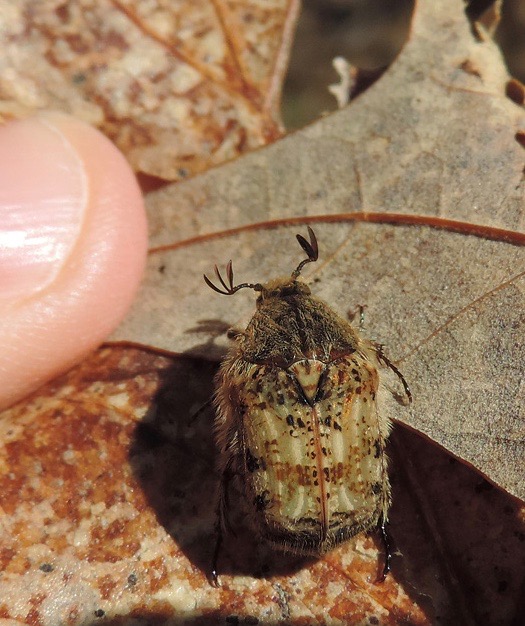
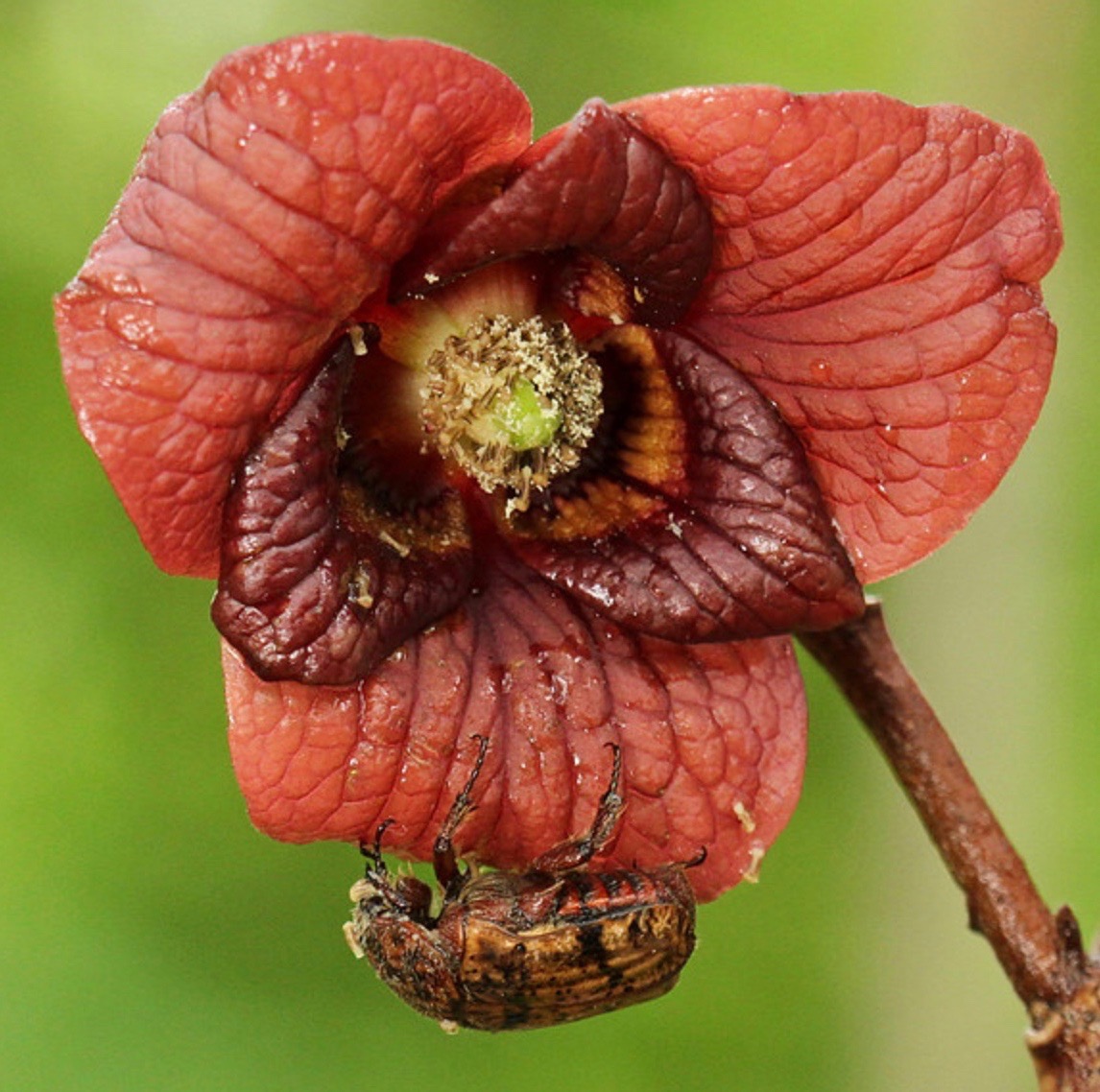
Photos LEFT and MIDDLE from Maryland Biodiversity Checklist
• RIGHT from Matt Buckinham, Flickr 2015
ABOVE: Published scientific papers have reported two genera of scarab beetles as effective pollinators of more southerly species of genus Asimina (whose flowers are smaller than the northern species, but have similar structure): Trichiotinus (left) and, to a lesser extent, Euphoria inda (middle and right). Notice that the photo in middle shows Euphoria in the context of leaf litter. Flower pollinating beetles generally are neither carrion beetles nor dung beetles. That is, they lay their eggs not in rotting meat or dung but into rotting wood or thick leaf mulch, where larval grubs feed and eventually pupate. Key papers on Asimina species that identify beetle pollinators:
• "Effects of Fire and Pollinator Visitation on the Reproductive Success of Asimina reticulata (Annonaceae), the Netted Pawpaw", by Louise K. Barton and Eric S. Menges, 2018, Castanea. (Note: Trichiotinus viridans, the "hairy flower scarab" is documented as the most prevalent visitor, and "low fruit set may be due to the lack of an effective pollinator, resulting in inbreeding depression.... Our study confirms that A. reticulata is self-compatible only if pollen is able to move among flowers, and we found that, in most cases, fruit was aborted prematurely and was found littering the ground beneath the plants.")
• "How diverse are Annonaceae with regard to pollination?", by Gerhard Gottsberger, 2012, Botanical Journal of the Linnean Society. (Note: In this paper two Florida species, Asimina obovata and Asimina pygmaea are linked with pollinating beetle species in Trichiotinus and Euphoria genera. These flowers are categorized as "diurnal without thermogenesis.")
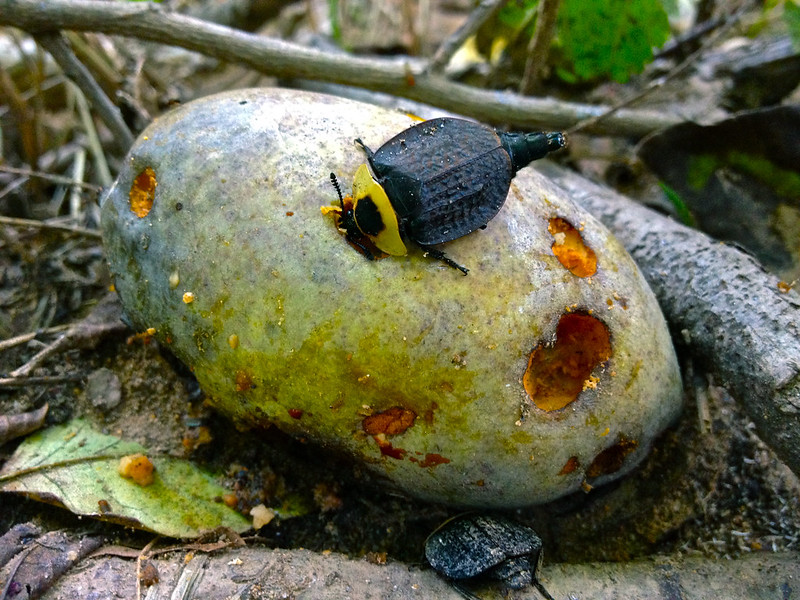
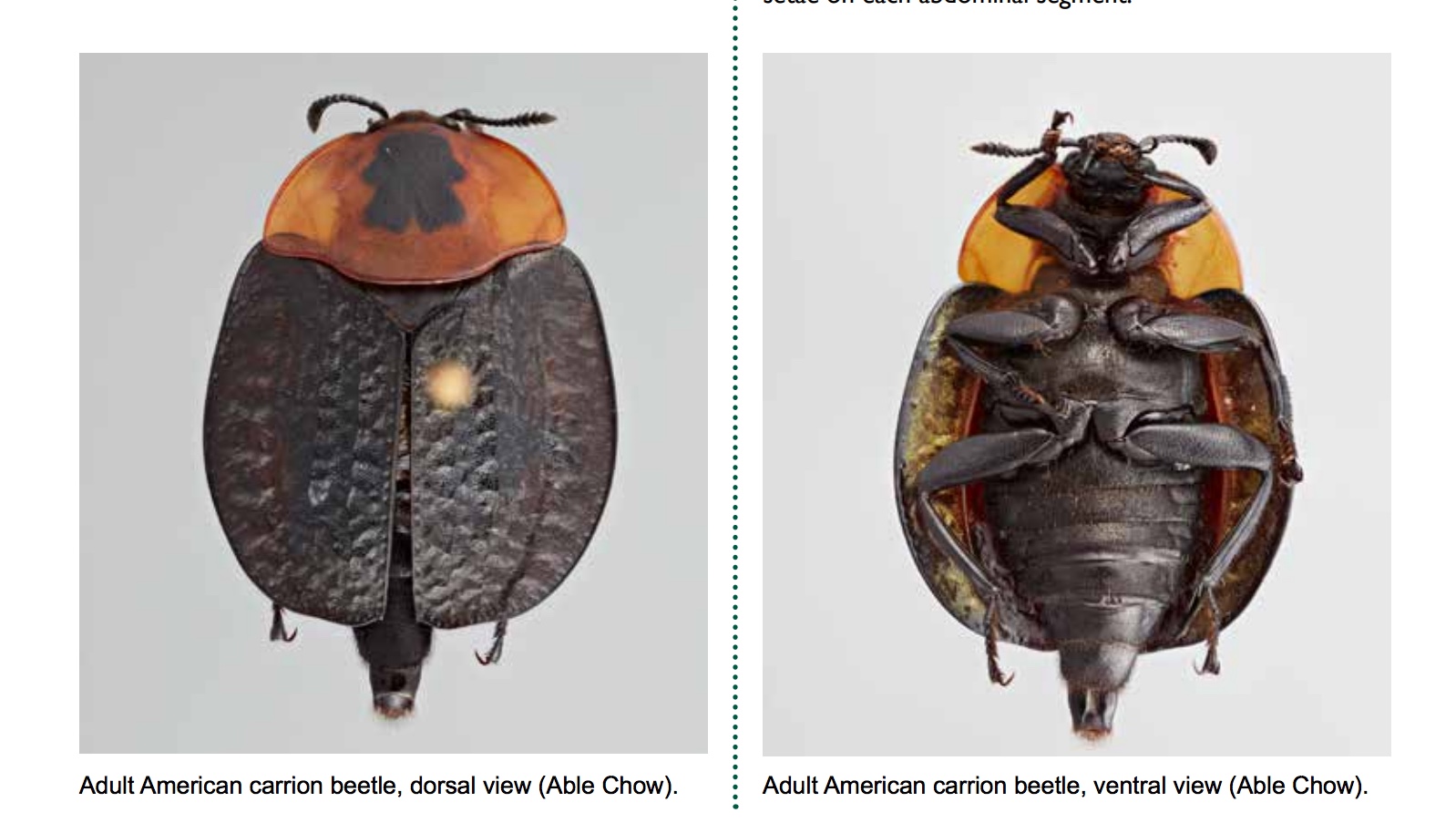
Photos from Maryland Biodiversity Checklist, Fritz Flohr Reynolds.
ABOVE: The American carrion beetle, Necrophilia americana, requires carrion for egg-laying and its larval stage, but as an adult it will happily feed on mushrooms — and fermenting pawpaw fruit. Note the lack of "hairs" on this beetle and thus its inability to serve as a pollinator.
A 2006 paper by Katherine R. Goodrich et al., "When Flowers Smell Fermented: The Chemistry and Ontogeny of Yeasty Floral scent in Pawpaw (Asimina triloba)", was published in International Journal of Plant Science. It offers evidence that carrion beetles are not involved in pawpaw pollination: "We did not detect the dimethyl oligosulfides that characterize the microbial decomposition of meat and universally constitute the odors of carrion-mimicking flowers." Instead, the authors reported a "yeastlike fragrance" in pawpaw flowers. However, "fermentation volatiles were largely absent from female-stage androgynoecia". (Many technical details in this paper may be useful for project participants.)
RECOMMENDED READING: In addition to various technical papers cited and linked here, a 296-page book on pawpaw is highly recommended: Pawpaw: In Search of America's Forgotten Fruit, by Andrew Moore, 2015, Chelsea Green.
• "The diversity and evolution of pollination systems in Annonaceae", by Richard M.K. Saunders, 2012, Botanical Journal of the Linnean Society:
... There are two distinct floral forms within genus Asimina. One group (consisting of A. parviflora and A. triloba) possesses small maroon flowers that emit a foetid aroma; and the other group (consisting of all other species) possesses large, white, pink or yellow flowers that emit a more pleasant fragrance (Kral, 1960; Goodrich & Raguso, 2009). These differences clearly represent different pollination syndromes. Observations of floral visitors confirm that the foetid-smelling species are visited by small flies and/or small beetles (Willson & Schemske, 1980; Norman etal., 1992; Rogstad, 1993), whereas the fragrant species are typically visited by large beetles (Norman & Clayton, 1986; Norman et al., 1992) or rarely by flies (Uphof, 1933; Norman et al., 1992).
... Annonaceae flowers are visited by a taxonomically diverse range of insects: predominantly beetles (Coleoptera), but also thrips (Thysanoptera), flies (Diptera) and, rarely, bees (Hymenoptera) and cockroaches (Dictyoptera). Species are typically pollinated by only one of these groups, although there are several examples of species that are pollinated by more than one group, including: .... Asimina parviflora (Norman et al., 1992), A. pygmaea (Uphof, 1933; Norman & Clayton, 1986; Norman et al., 1992) and A. triloba (Willson & Schemske, 1980; Johnson & Willson, cited in Norman et al., 1992) are visited by flies and beetles.
... Despite the vast diversity of dipterans and their evident importance in pollination, there are few reports of fly pollination in Annonaceae. Flower visits by flies have only been reported for Annona (Webber, 1981b; as secondary floral visitors only), Asimina (Norman et al., 1992), Monodora (Gottsberger, 1985; Gottsberger et al., 2011), Pseuduvaria (Morawetz, 1988; Silberbauer-Gottsberger et al., 2003; Su et al., 2005) and Uvariopsis (Gottsberger et al., 2011). It should be noted, however, that Norman et al. (1992) did not observe any pollen attached to the common drosophilid flies that visited Asimina flowers (pollination resulted from visits by nitidulid beetles and rarer calliphorid flies), and that pollen transfer between flowers was not demonstrated in any of the other studies. ... To avoid confusion of stimuli, Calliphoridae (blowflies), which lay eggs in dung and carrion, favour yellow colours in the presence of sweet scents, but brown-purple colours in the presence of foetid scents (Kugler, 1956). The latter pollination system is observed in Asimina parviflora (Norman et al., 1992) and operates by DECEIT as the flies visit the flowers in order to lay eggs. Sapromyiophilous flowers, furthermore, often have partially enclosed pollination chambers that require the flies to crawl in through narrow openings (Faegri & van der Pijl, 1979).
• "Phylogenetic Analysis of the North American Beetle Genus Trichiotinus (Coleoptera: Scarabaeidae: Trichiinae)", by T. Keith Philips et. al, 2016, Psyche: A Journal of Entomology.
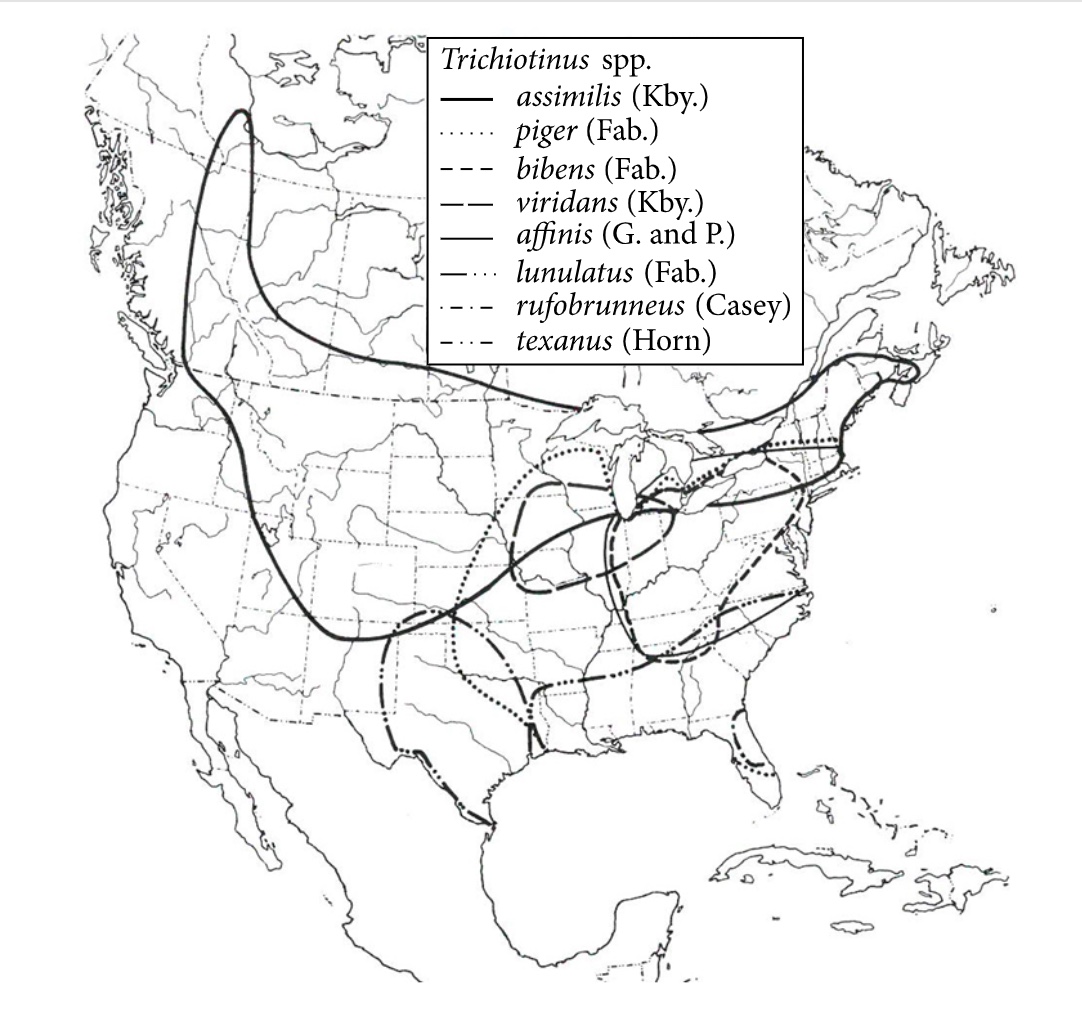
... Adults are good fliers and forage on a variety of flowers while larvae are known to feed on various species of decaying hardwoods.... Trichiotinus is dependent upon decaying hardwoods as larval food including oak [6]. Jackson et al. [39] present evidence for a split in distribution of oaks (Quercus spp.) during the most recent glacial maximum on either side of the Mississippi drainage and may be indicative of the effects of earlier glacial maxima as well. P. A. Delcourt and H. R. Delcourt [40, 41] also postulated the presence of spruce (Picea glauca) forests in the Lower Mississippi Valley. This extension south of these more cool adapted forests all the way to the gulf coast that divided the hardwood forests into eastern and western blocks was thought to be due to glacial meltwater creating a cooler climate locally [42].
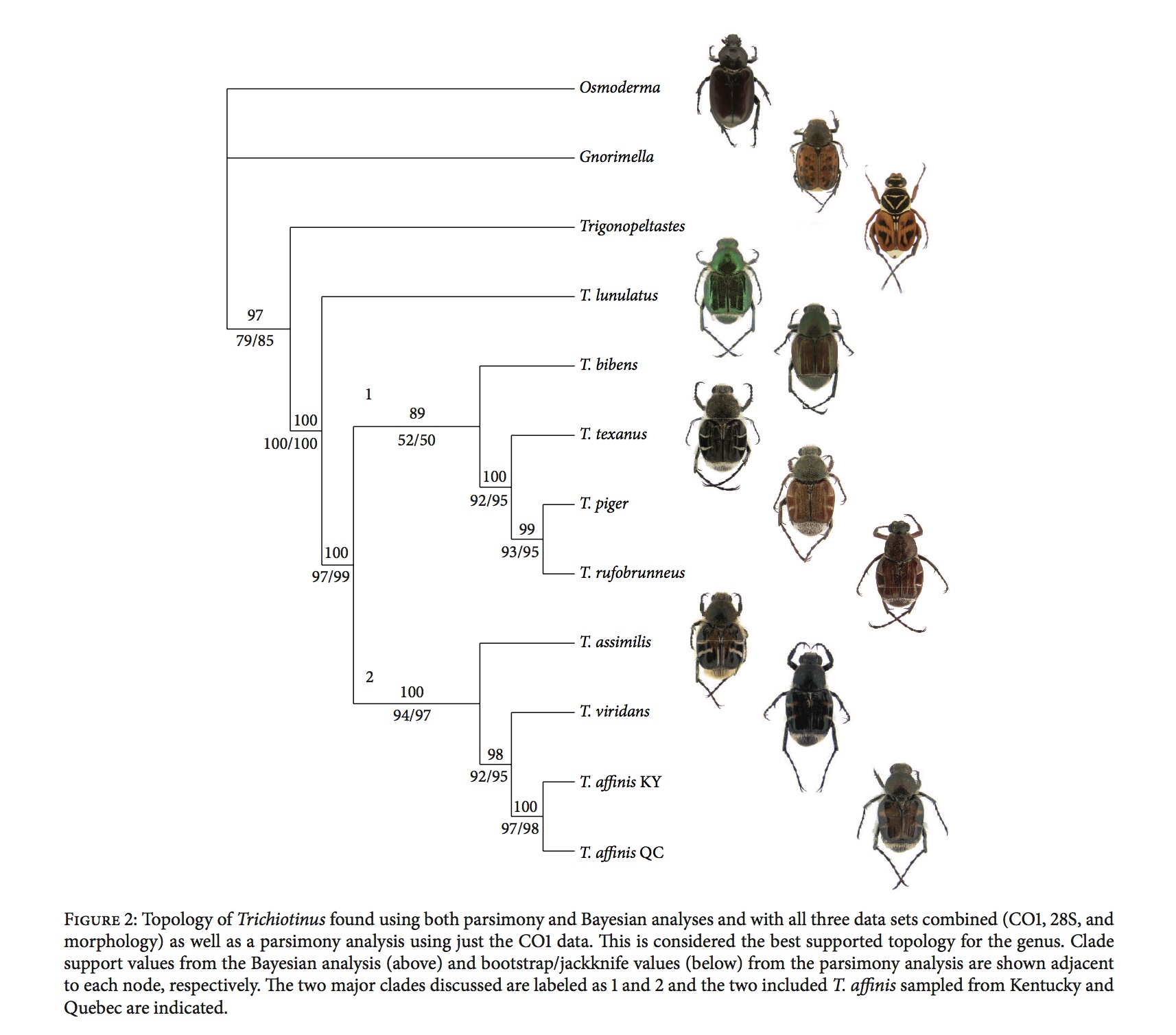
• "Monographic Revision of the American Genus Euphoria Burmeister, 1842 (Coleoptera: Scarabaeidae: Cetoniinae)", by Jesus Orozco, 2012, BioOne Complete.
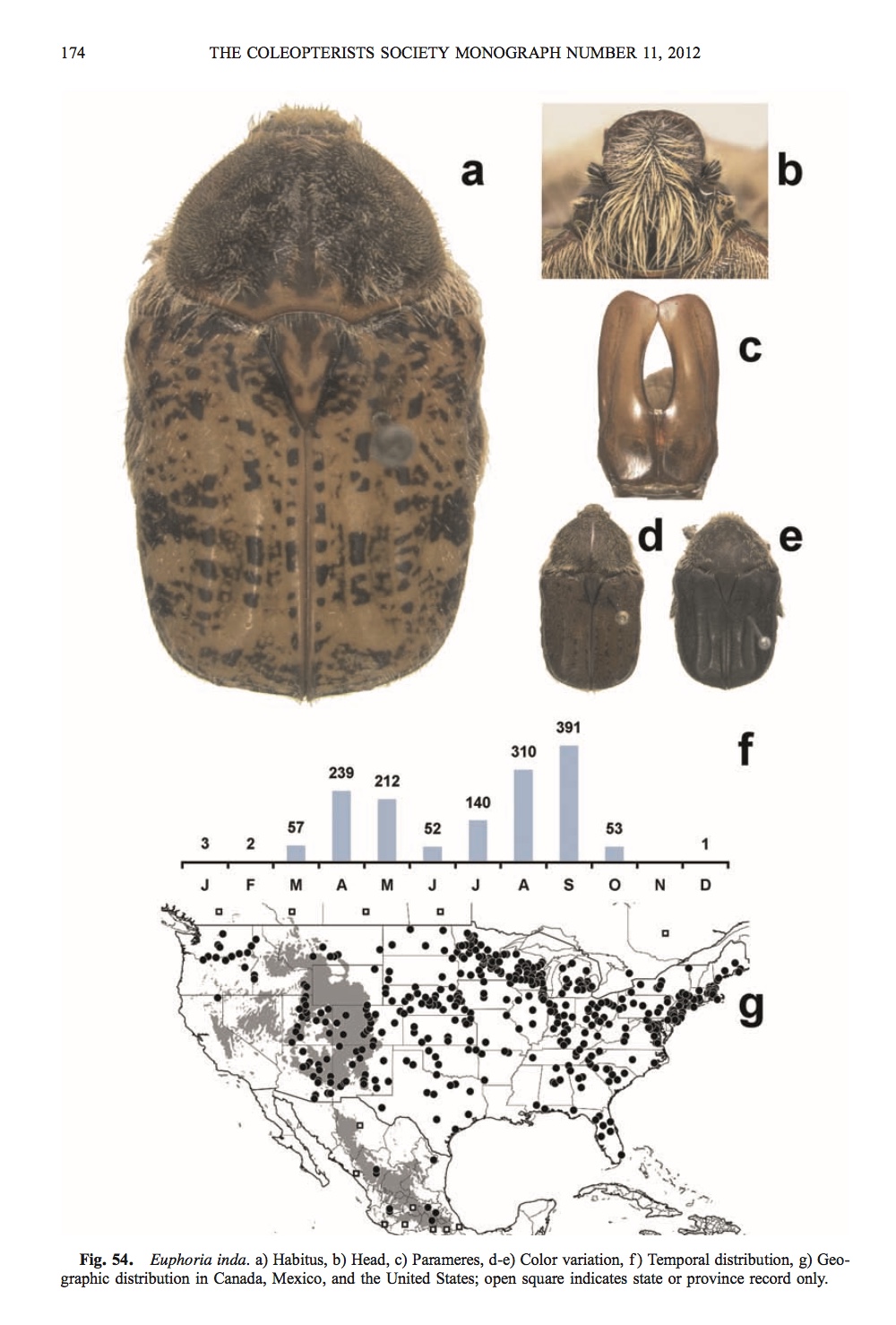
• RETURN TO TOP
Table of Topics for Parts 2 and 3
(on separate webpages)
PART 2: RESTORING RECIPROCITY
• Appreciating Asimen: Geography and Taxonomic Relatives
• Appreciating Asimen: Fully resists deer browsing
• Appreciating Asimen: Prevents Invasion by Japanese Stiltgrass
• Appreciating Asimen: Ethnobotany
• Toward Renewing and Expanding Reciprocity
• Could pawpaw help compensate for the loss of Black Ash as a fiber source?
• Could pawpaw restore the subcanopy where deer are overpopulated?
• Appreciating Asimen: Original Instructions
• New York State: Where Pawpaw is a "Threatened Species"
• What About American Persimmon?
PART 3: WILD-PLANTING EXPERIMENTS
• BASELINE DOCUMENTATION of a Wild Patch (Saline River, Michigan, 2020 & 2021)
• Learning about Germination (2023)
• Helping Forests Walk: Assisted Migration of Pawpaw
• Helping Forests Walk 2025